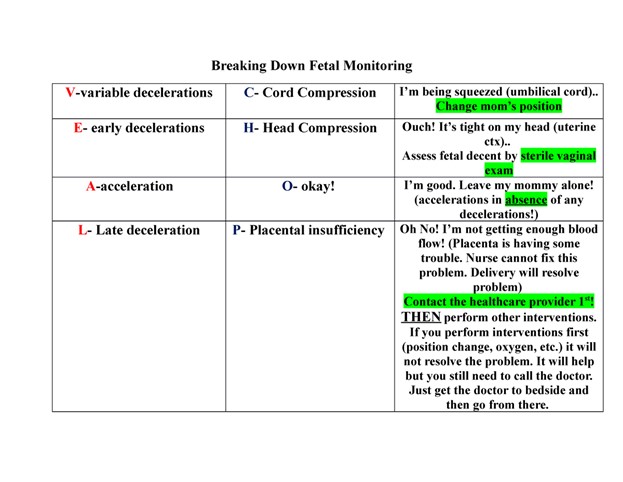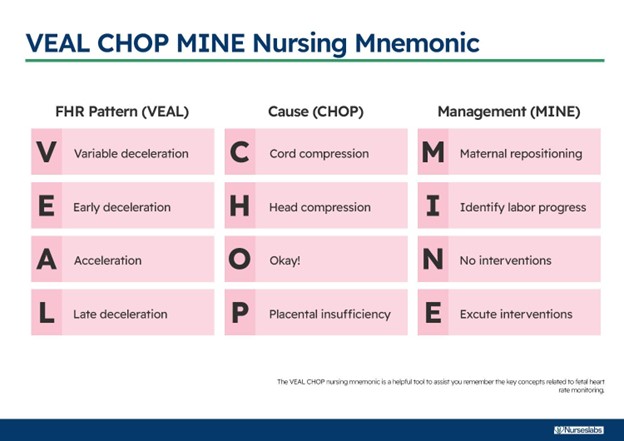A nurse is caring for a client who is undergoing an oxytocin (pitocin) infusion for induction of labor.
The nurse notices that the FHR shows a pattern of late decelerations, which are decelerations that begin after the peak of the contraction and return to baseline after the contraction ends.
What is the most likely cause of these decelerations?
Fetal head compression
Umbilical cord compression
Uteroplacental insufficiency
Maternal hypotension.
The Correct Answer is C
Uteroplacental insufficiency. Late decelerations are decelerations that begin after the peak of the contraction and return to baseline after the contraction ends. They are caused by inadequate blood flow and oxygen delivery to the fetus through the placenta. This can be due to maternal hypotension, uterine hyperstimulation, placental abruption, or other factors.
Choice A is wrong because fetal head compression causes early decelerations, which are decelerations that begin and end with the contraction.
Choice B is wrong because umbilical cord compression causes variable decelerations, which are abrupt drops in the fetal heart rate that vary in shape and timing.
Choice D is wrong because maternal hypotension can cause uteroplacental insufficiency, but it is not the only cause. Also, maternal hypotension would affect the fetal heart rate baseline, not just the decelerations.
Normal ranges for fetal heart rate are 110 to 160 beats per minute for baseline and 15 beats per minute above or below baseline for variability.

Nursing Test Bank
Naxlex Comprehensive Predictor Exams
Related Questions
Correct Answer is A
Explanation
Accelerations.According to the National Institute of Child Health and Human Development (NICHD) terminology, accelerations are defined as transient increases in the FHR of at least 15 bpm above the baseline for at least 15 seconds.Accelerations are a reassuring sign of fetal well-being and oxygenation.
Early decelerations are decreases in the FHR that coincide with the onset and end of a uterine contraction.They are caused by fetal head compression and are usually benign.
Late decelerations are decreases in the FHR that begin after the peak of a uterine contraction and do not return to baseline until after the contraction ends.They are caused by uteroplacental insufficiency and are a sign of fetal hypoxia.
Variable decelerations are abrupt decreases in the FHR that vary in timing.

Correct Answer is A
Explanation
This means that the fetal heart rate (FHR) increases by at least 15 beats per minute (bpm) for at least 15 seconds, twice in a 10-minute period.This indicates that the baby is healthy and getting enough oxygen.
Nonreactive.
This means that the FHR does not show the expected accelerations in response to movement.This may indicate that the baby is not well or needs further testing.
Indeterminate.
This means that the FHR shows some accelerations, but not enough to be considered reactive.This may indicate that the baby is asleep or needs more time to show reactivity.
Abnormal.
This means that the FHR shows decelerations, which are drops in the heart rate below the baseline.This may indicate that the baby is in distress or has a problem with the umbilical cord or placenta.
Whether you are a student looking to ace your exams or a practicing nurse seeking to enhance your expertise , our nursing education contents will empower you with the confidence and competence to make a difference in the lives of patients and become a respected leader in the healthcare field.
Visit Naxlex, invest in your future and unlock endless possibilities with our unparalleled nursing education contents today
Report Wrong Answer on the Current Question
Do you disagree with the answer? If yes, what is your expected answer? Explain.
Kindly be descriptive with the issue you are facing.
